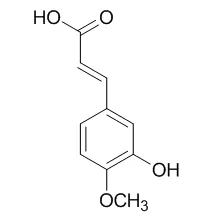| In vitro: |
| Molecules. 2013 May 30;18(6):6439-54. | | Isoferulic acid, a new anti-glycation agent, inhibits fructose- and glucose-mediated protein glycation in vitro.[Pubmed: 23722732] | The inhibitory activity of Isoferulic acid (IFA) on fructose- and glucose-mediated protein glycation and oxidation of bovine serum albumin (BSA) was investigated.
METHODS AND RESULTS:
Our data showed that IFA (1.25-5 mM) inhibited the formation of fluorescent advanced glycation end products (AGEs) and non-fluorescent AGE [Nε-(carboxymethyl) lysine: CML], as well as the level of fructosamine. IFA also prevented protein oxidation of BSA indicated by decreasing protein carbonyl formation and protein thiol modification. Furthermore, IFA suppressed the formation of β-cross amyloid structures of BSA.
CONCLUSIONS:
Therefore, IFA might be a new promising anti-glycation agent for the prevention of diabetic complications via inhibition of AGEs formation and oxidation-dependent protein damage. | | Nat Prod Commun. 2011 Sep;6(9):1285-8. | | Evaluation of antioxidant activity of isoferulic acid in vitro.[Pubmed: 21941899] | Isoferulic acid (3-hydroxy-4-methoxycinnamic acid, IFA), the isomer of ferulic acid (4-hydroxy-3-methoxycinnamic acid), is a rare phenolic acid occurring in Rhizoma Cimicifugae. Unlike ferulic acid, which has been well investigated, the antioxidant activity of IFA has not been measured.
METHODS AND RESULTS:
In this study, IFA was systematically evaluated for its in vitro antioxidant activity for the first time. IC50 values were calculated of 7.30 +/- 0.57, 4.58 +/- 0.17, 1.08 +/- 0.01, 8.84 +/- 0.43, 7.69 +/- 0.39, 1.57 +/- 0.2, 13.33 +/- 0.49 microg/mL, respectively, for lipid peroxidation, DPPH (1,1-diphenyl-2-picrylhydrazyl radical) and ABTS (3-ethylbenzthiazoline-6-sulfonic acid diammonium salt) radical scavenging, reducing power on Fe3+ and CU2+ ions, and hydroxyl and superoxide anion radical scavenging. Comparison with the IC50 values with those of the positive controls, Trolox and butylated hydroxyanisole (BHA), it can be concluded that Isoferulic acid is an effective natural antioxidant in both lipid and aqueous media. | | Planta Med. 1995 Jun;61(3):221-6. | | Inhibitory effect of ferulic acid and isoferulic acid on murine interleukin-8 production in response to influenza virus infections in vitro and in vivo.[Pubmed: 7617763 ] | We investigated the effect of ferulic acid (FA) and Isoferulic acid (IFA), which are active components of the rhizoma of Cimicifuga species used frequently as anti-inflammatory drugs in Japanese Oriental medicines, on murine interleukin-8 (IL-8) production in response to influenza virus infections in vitro and in vivo by antibody-sandwich enzyme-linked immunosorbent assay.
METHODS AND RESULTS:
In the in vitro study, the murine macrophage cell line RAW 264.7 was infected with influenza virus at a dose of 10 plaque forming units (PFU)/cell and cultured in the presence or absence of drugs. Both FA and IFA reduced the IL-8 levels in the 20-h conditioned medium in comparison with control in a dose-dependent manner. The effect of IFA was greater than that of FA: IL-8 levels were reduced to 43% and 56% of the control in the presence of 100 micrograms/ml of IFA and FA, respectively. In the in vivo study, mice were infected with 1,000 PFU of virus and received daily oral administrations of Cimicifuga heracleifolia extract (5 mg/mouse/day), FA (0.5 mg/mouse/day), IFA (0.125 mg/mouse/day), or phosphate buffered saline. The three drugs showed a tendency to reduce IL-8 levels in bronchoalveolar lavage (BAL) obtained 2 days after infection. Moreover, both FA and IFA also significantly reduced the number of exuded neutrophils into BAL. However, the drug administrations did not affect the virus yields in BAL.
CONCLUSIONS:
These data suggest that FA and IFA are novel and potent inhibitors of murine IL-8 production and might act as one of the main components of anti-inflammatory rhizoma of Cimicifuga species. |
|






 Cell. 2018 Jan 11;172(1-2):249-261.e12. doi: 10.1016/j.cell.2017.12.019.IF=36.216(2019)
Cell. 2018 Jan 11;172(1-2):249-261.e12. doi: 10.1016/j.cell.2017.12.019.IF=36.216(2019) Cell Metab. 2020 Mar 3;31(3):534-548.e5. doi: 10.1016/j.cmet.2020.01.002.IF=22.415(2019)
Cell Metab. 2020 Mar 3;31(3):534-548.e5. doi: 10.1016/j.cmet.2020.01.002.IF=22.415(2019) Mol Cell. 2017 Nov 16;68(4):673-685.e6. doi: 10.1016/j.molcel.2017.10.022.IF=14.548(2019)
Mol Cell. 2017 Nov 16;68(4):673-685.e6. doi: 10.1016/j.molcel.2017.10.022.IF=14.548(2019)